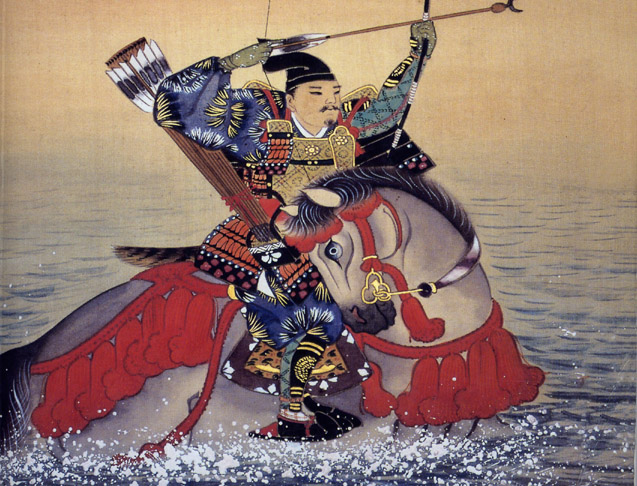Personal History Column: Instances of Amazing Historical Marksmanship
Nasu no Yoichi, a Minamoto Warrior, managed to shoot a fan that was placed on top of an enemy ship’s mast during the Genpei War.
Since the dawn of time, many things have remained true.
The sun, for example, will always rise in the East and always set in the West. Coleslaw will always be disgusting. And history has been – and always will be – humanity’s most source of some of the most unbelievable stories. The truth, after all, is stranger than fiction.
Without further ado, here are two of my favorite historical tales regarding those men who – if nothing else – are more accurate than the Clippers’ offense. And though today we won’t be talking about the Denver Nuggets, we will be talking about marksmen.
1) Billy Dixon and “The Shot”: Second Battle of Adobe Walls.
Billy Dixon was no stranger to the rifle, pursuing a career as a Bison Hunter in the American West. The West Virginia native rose to fame after helping found the now-abandoned town of Adobe Walls, Texas, and went on to become only the 8th American to win the Medal of Honor as a civilian.
1880’s Texas was a turbulent place, and many frontier towns, such as Adobe Walls, were rightfully fearful of Native American raiding parties (specifically from the Comanche – who were known for their ruthless and lightning-paced incursions).
Adobe Walls had once been besieged by the Comanche, though that onslaught was repelled, thanks to the town’s small U.S. Army garrison. The garrison had left since the last raid, leaving Dixon with only 27 other men under his command. As a force of 700 Comanche looked down at him from the surrounding canyon, Dixon felt hopeless. He loaded his rifle and aimed out at a Comanche on horseback, staring back at him through the distance. He raised his gun in the air, and with a movement of his finger, he pulled the trigger.
After a loud bang and a couple seconds, the Comanche warrior tumbled off his horse, killed by Dixon’s shot. Fearing Dixon was like some enchanted warrior, the Comanche retreated, and the town was safe for the time being. Dixon’s shot was later estimated at around 1,538 yards, or nine-tenths of a mile.
Other things that are nine-tenths of a mile? I thought you’d never ask:
- 15 football fields
- Half the distance from the US to Russia at their closest point
- A jog around the Vatican City
- Half of Monaco’s coastline (when it isn’t covered in Lamborghinis, yachts, and F1 courses)
- Lil Uzi Vert, when standing on his money (probably)
- 29 Hixon Pools (and Taft’s pool, for good measure)
2) Flirting and Fans: Nasu no Yoichi, Battle of Yashima.
Medieval Europe wishes it could be medieval Japan.
Think of this period of Japanese history like a Wrestlemania battle royale: action and showmanship on display, quite a lot of fighting (to be expected), and crowds of drunk spectators betting on different teams.
An all-you-can-eat buffet of swashbuckling samurai, political turbulence, and new technology, Japan underwent a period of massive cultural and governmental change from roughly 1180 to 1600. The period started off with the Genpei War, during which our next feat of marksmanship takes place.
The Genpei War was waged by two rival clans – the Minamoto and the Taira – as they vied for control of Japan. Until roughly 1868, Japan was ruled by a Shogun, a military dictator who held true power over the country, while the Emperor lived in exile and held a figurehead position. The Minamoto clan’s victory in the Genpei War led to the foundation of the first shogunate.
The Genpei War was no stranger to weird and wacky moments. The war saw the drowning of Japan’s youngest Emperor at only six years old, as well as Samurai attacking a flock of waterfowl, insisting the birds were enemy warriors.
It makes sense, then, that our main incident could only happen during the Genpei War.
At the Battle of Yashima, Nasu no Yoichi, a Minamoto Warrior, was surveilling the enemy fleet atop his horse. In the distance, he saw a beautiful Taira woman who called out to him from the bow of an enemy ship. He moved closer, attracted to her personality (of course) and heard her dare him to shoot a fan that was placed on top of the ship’s mast.
Accepting the bet, Nasu waded out into the ocean atop his horse. With one graceful motion, he took an arrow from his quiver and aimed directly at the fan, promptly knocking it off.
The distance of his shot is unknown, but historical accounts do include that it was a very windy day, with both Nasu and the boat rocking about in the rough water. Many historians consider it to be the greatest shot in Japanese history, truly worthy of its mythical status.
As I’m sure you now know, being a good marksman is no easy task. During the Vietnam War, the average U.S. Army soldier shot 50,000 rounds for every fatal shot made, costing the United States government roughly 23,000 dollars per confirmed kill.
Sometimes, however, you only get one shot. As we’ve seen, for a select few, that is all it takes – no matter the distance or the conditions.






